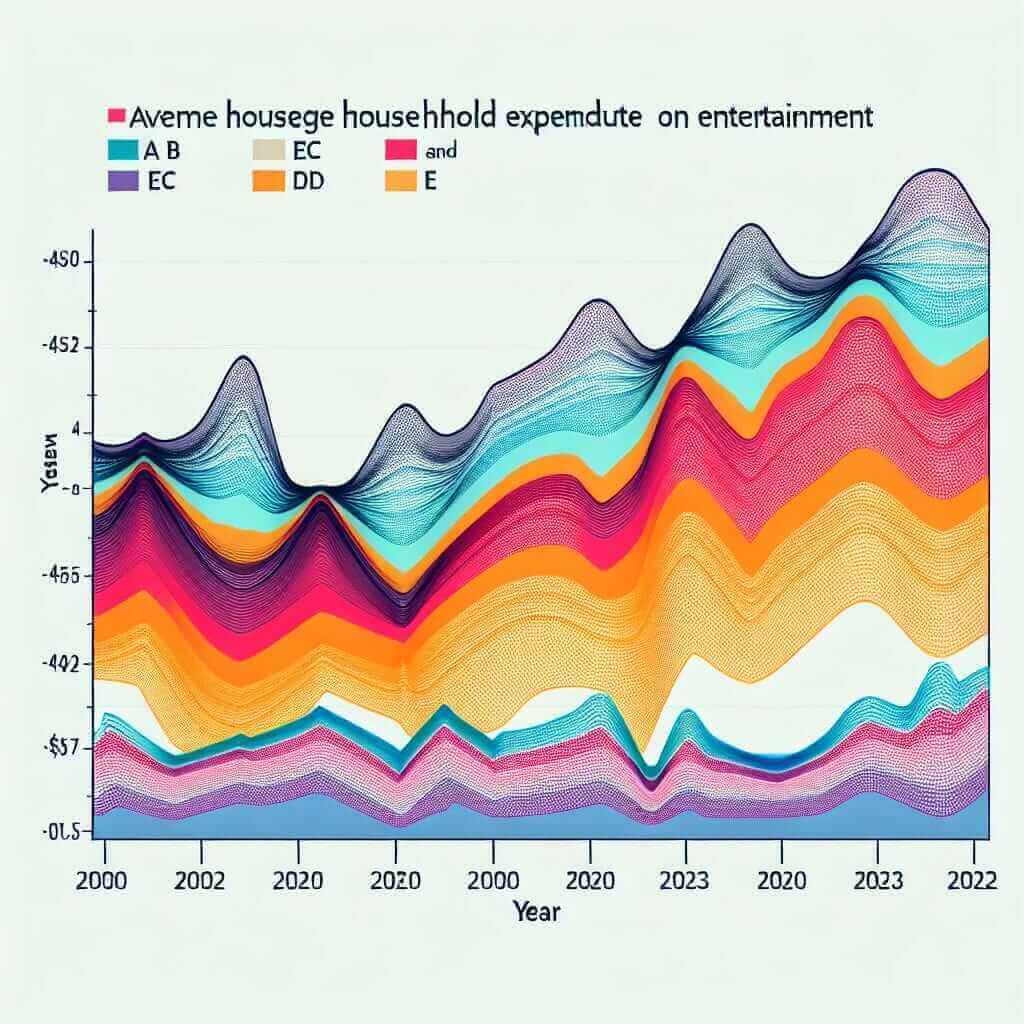Understanding trends in household spending on entertainment over an extended period can be a crucial element in mastering IELTS Writing Task 1. In this lesson, we will delve into the topic “Average Household Spending on Entertainment (2000-2023),” examine related sample tasks, analyze relevant vocabulary and grammatical structures, and share tips for achieving a high score.
Understanding the Task: Analyzing Household Spending on Entertainment
In the IELTS Writing Task 1, candidates are often asked to describe and interpret data presented in various forms, such as line graphs, bar charts, tables, or pie charts. This topic focuses on household spending trends on entertainment over a period of 23 years.
Here are three sample tasks related to this topic:
- The line graph below shows the average household spending on entertainment from 2000 to 2023 in five different countries. Summarize the information by selecting and reporting the main features, and make comparisons where relevant.
- The bar chart illustrates the changes in average household expenditure on entertainment, comparing urban and rural households between 2000 and 2023. Summarize the information by selecting and reporting the main features, and make comparisons where relevant.
- The table presents data on the average household spending on various entertainment sectors from 2000 to 2023. Summarize the information by selecting and reporting the main features, and make comparisons where relevant.
Exploring a Sample Task
Let’s choose the first sample task to develop further:
Task: The line graph below shows the average household spending on entertainment from 2000 to 2023 in five different countries. Summarize the information by selecting and reporting the main features, and make comparisons where relevant.
Sample Data
To create a realistic practice scenario, we will use a hypothetical line graph with the following data:
| Year | Country A | Country B | Country C | Country D | Country E |
|---|---|---|---|---|---|
| 2000 | 300 | 400 | 500 | 350 | 450 |
| 2005 | 320 | 420 | 530 | 370 | 460 |
| 2010 | 340 | 450 | 560 | 390 | 465 |
| 2015 | 360 | 480 | 590 | 410 | 470 |
| 2020 | 380 | 510 | 620 | 430 | 475 |
| 2023 | 400 | 540 | 650 | 450 | 480 |

Analysis of the Task
- Understanding the Task: Identify the trends shown in the line graph and note key changes over time for each country.
- Grouping Information: Group countries with similar trends together for a clearer analysis.
- Comparing Data: Highlight comparisons where significant differences or similarities exist.
Writing Sample
The line graph illustrates the average household spending on entertainment from 2000 to 2023 in five different countries: A, B, C, D, and E.
Overall, the spending on entertainment increased in all five countries over the 23-year period. Country C experienced the highest level of spending throughout the entire period, while Country A had the lowest.
Initially, in 2000, Country C’s households spent significantly more on entertainment, at around $500. This figure gradually rose to $650 by 2023. On the other hand, Country A’s spending started at $300 in 2000 and followed a steady upward trend to reach $400 in 2023.
Countries B and E had similar patterns, starting from $400 and $450, respectively, in 2000 and each seeing gradual increases of approximately $140 and $30 by 2023. Country D’s expenditure showed a consistent upward trajectory, starting at $350 and reaching $450 by the end of the period.
In conclusion, while all five countries observed an upward trend in entertainment spending, Country C consistently led in expenditure levels, and Country A remained at the bottom throughout the timeframe.
Word count: 190
Key Points to Remember
- Include an Overview: Start with an overview that highlights general trends.
- Group Data Effectively: Group similar data points for cohesive analysis.
- Use Comparative Language: Employ comparative structures like “while,” “whereas,” and “compared to.”
Key Vocabulary and Grammar for This Topic
Vocabulary
- Trend (noun): a general direction in which something is developing or changing (ˈtrɛnd)
- Trajectory (noun): the path followed by a projectile flying or an object (ˈtrædʒɪˌɛktəri)
- Expenditure (noun): the action of spending funds (ɪkˈspɛndɪtʃər)
- Consistent (adjective): acting or done in the same way over time (kənˈsɪstənt)
- Significant (adjective): sufficiently great or important to be worthy of attention (sɪɡˈnɪfɪkənt)
- Initially (adverb): at first (ɪˈnɪʃəli)
- Approximately (adverb): roughly (əˈprɒksɪmətli)
- Gradually (adverb): in a gradual way; slowly (ˈɡrædʒuəli)
- Distinct (adjective): recognizably different in nature from something else (dɪˈstɪŋkt)
- Hypothetical (adjective): based on or serving as a hypothesis (ˌhaɪpəˈθɛtɪkl)
Grammar Tips
- Comparative Structures: “significantly more,” “the highest level,” “slightly higher.”
- Past Simple and Present Perfect: “experienced,” “started,” “has risen.”
- Linking Words: “overall,” “while,” “on the other hand,” “whereas.”
Conclusion
When tackling IELTS Writing Task 1, especially data-driven topics such as “Average Household Spending on Entertainment (2000-2023),” make sure to:
- Provide a clear overview.
- Group similar data points.
- Use precise comparative language.
- Maintain clarity and coherence throughout your writing.
By adhering to these strategies, you can aim for a Band 7+ in your IELTS Writing Task 1.